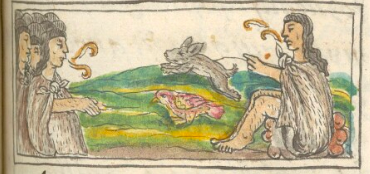tlaciuhqui (FCbk10f125r)
This iconographic example, featuring a diviner (tlaciuhqui), is included in this digital collection for the purpose of making comparisons with related hieroglyphs. The term selected for this example comes from the text the page after this image in the Digital Florentine Codex. There is no gloss, per se. This example shows a man with long hair, wearing a cloak knotted o the chest and made from hide. He is sitting on a rock (tetl, drawn as though a hieroglyph), facing left. He is also speaking, with two brown speech scrolls emerging from his mouth. The contextualizing image shows that he is speaking to a group of men with the same hairstyle and hide capes, and one of them speaks in his direction. The text explains that these are Otomies who are consulting the diviner. The text also informs the reader that the diviner was a “wise man,” equal to and resembling a deity, and addressing the others as though he were that deity. He could communicate with the deity on behalf of the Otomies and share what he learned. All the men in this scene have capes with a brown shading, giving them a three-dimensionality, and they are all sitting in a landscape. These are European artistic traditions that the tlacuilo has learned through colonial education. The landscape is interesting for the two animals in front of the tlaciuhqui: a colorful bird facing left, and a rabbit that is running (movement) left toward the Otomies.
Stephanie Wood
This is the only example of a tlaciuhqui in this digital collection as of October 2025. However, one can do a Quick Search for the word “wise” and find many examples of people named Tlamauh, Tlamauhcatl, Tlamauhqui, plus Ixtlamati. Of course, many of these personal names may relate to the place name, Tlamauhco. There is one that is part of Ocotelulco in the state of Tlaxcala, for instance. But that place may have an association with wisdom. Also included in the search results for “wise” will be terms such as tlamati and tlamatini.
Stephanie Wood
tlaciuhqui
Stephanie Wood
1577
Jeff Haskett-Wood
sabio, sabiduría, adivina, conocimiento, palabras, hablar, tlatolli, tlahtolli
tlaciuhqui, a diviner, https://nahuatl.wired-humanities.org/content/tlaciuhqui
el adivino
Stephanie Wood
Available at Digital Florentine Codex/Códice Florentino Digital, edited by Kim N. Richter and Alicia Maria Houtrouw, "Book 10: The People", fol. 125r, Getty Research Institute, 2023. https://florentinecodex.getty.edu/en/book/10/folio/125r/images/0 Accessed 2 October 2025.
Images of the digitized Florentine Codex are made available under the following Creative Commons license: CC BY-NC-ND (Attribution-NonCommercial-NoDerivs 4.0 International). For print-publication quality photos, please contact the Biblioteca Medicea Laurenziana ([email protected]). The Library of Congress has also published this manuscript, using the images of the World Digital Library copy. “The Library of Congress is unaware of any copyright or other restrictions in the World Digital Library Collection. Absent any such restrictions, these materials are free to use and reuse.”


